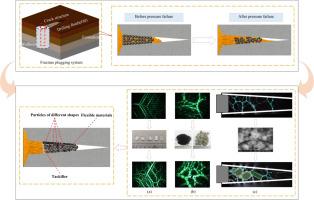深层地能地层油基钻井液条件下的裂缝封堵失效:细观力学结构演化视角
IF 4.6
2区 工程技术
Q2 ENGINEERING, CHEMICAL
引用次数: 0
摘要
颗粒封堵带的结构完整性通过其承受构造压力的能力直接影响到油气和地热储层钻井作业的成功与否。在钻井过程中,油基钻井液对裂缝封堵带结构稳定性的影响是防止泄漏的关键。本研究采用光弹性实验研究了干燥、水基和油基条件下刚性颗粒堵塞区的力链演化。结果表明:干燥条件下压力呈线性上升后下降趋势,水基条件下压力呈波动趋势,油基条件下压力在多次波动后趋于稳定,承压能力最低。弱力链在数值上占主导地位。在负载下,强和中等力链增加。重点是油基条件下,强力链网相对稀疏,优势取向为60°;0°和240°方向不太普遍。这使得难以形成鱼骨状的高压承载结构,并且拓扑复杂性降低导致稳定性差。力链能量的演化受流体性质的影响:摩擦力的减小导致颗粒位移和结构损伤,破坏力链结构的完整性,诱发局部断裂破坏,进而引发宏观破坏。改性颗粒特性和添加增粘剂可以增强力链网络,提高堵层稳定性和抗剪强度。这些发现为深部裂缝性油藏钻井液体系的优化提供了实用策略。本文章由计算机程序翻译,如有差异,请以英文原文为准。

Fracture plugging failure under oil-based drilling fluids condition in deep geoenergy formations: A mesoscopic mechanical structure evolution perspective
The structural integrity of the particle plugging zone directly affects the success of drilling operations in oil, gas, and geothermal reservoirs through its ability to withstand tectonic pressures. The impact of oil - based drilling fluids on the structural stability of the fracture plugging zone is crucial for preventing leakage during the drilling process. This study employs photoelastic experiments to investigate force chain evolution in rigid particle plugging zones under dry, water-based, and oil-based conditions. Results show distinct behaviors: dry conditions exhibit linear pressure increases followed by decline, water-based conditions show fluctuating trends, and oil-based conditions stabilize after multiple fluctuations with the lowest pressure-bearing capacity. Weak force chains dominate numerically. Under load, strong and medium force chains increase. The key point is that under oil-based conditions, the strong force chain network is relatively sparse, with the dominant orientation being 60°; orientations along 0° and 240° are less prevalent. This makes it difficult to form a fishbone-like high-pressure-bearing structure, and the reduced topological complexity results in poor stability. The evolution of force chain energy is influenced by fluid properties: the decrease in friction leads to particle displacement and structural damage, which compromise the integrity of the force chain structure, induce local fracture failure, and consequently trigger macroscopic failure. Modifying particle properties and integrating tackifiers can enhance force chain networks, improving plugging zone stability and shear strength. These findings offer practical strategies for optimizing drilling fluid systems in deep fractured reservoirs.
求助全文
通过发布文献求助,成功后即可免费获取论文全文。
去求助
来源期刊

Powder Technology
工程技术-工程:化工
CiteScore
9.90
自引率
15.40%
发文量
1047
审稿时长
46 days
期刊介绍:
Powder Technology is an International Journal on the Science and Technology of Wet and Dry Particulate Systems. Powder Technology publishes papers on all aspects of the formation of particles and their characterisation and on the study of systems containing particulate solids. No limitation is imposed on the size of the particles, which may range from nanometre scale, as in pigments or aerosols, to that of mined or quarried materials. The following list of topics is not intended to be comprehensive, but rather to indicate typical subjects which fall within the scope of the journal's interests:
Formation and synthesis of particles by precipitation and other methods.
Modification of particles by agglomeration, coating, comminution and attrition.
Characterisation of the size, shape, surface area, pore structure and strength of particles and agglomerates (including the origins and effects of inter particle forces).
Packing, failure, flow and permeability of assemblies of particles.
Particle-particle interactions and suspension rheology.
Handling and processing operations such as slurry flow, fluidization, pneumatic conveying.
Interactions between particles and their environment, including delivery of particulate products to the body.
Applications of particle technology in production of pharmaceuticals, chemicals, foods, pigments, structural, and functional materials and in environmental and energy related matters.
For materials-oriented contributions we are looking for articles revealing the effect of particle/powder characteristics (size, morphology and composition, in that order) on material performance or functionality and, ideally, comparison to any industrial standard.
 求助内容:
求助内容: 应助结果提醒方式:
应助结果提醒方式:


